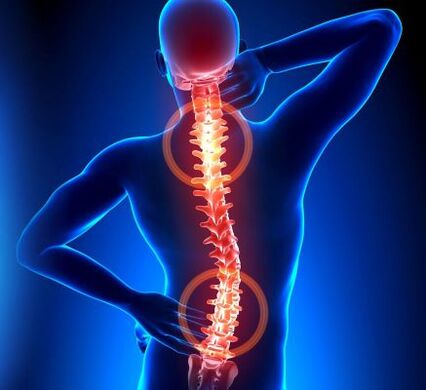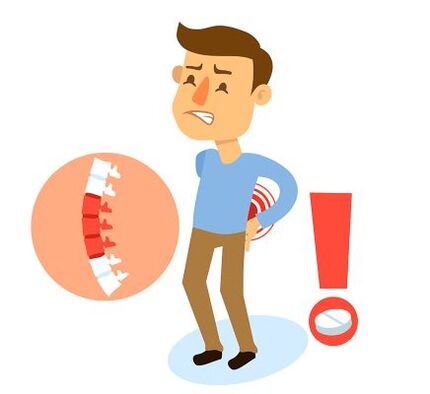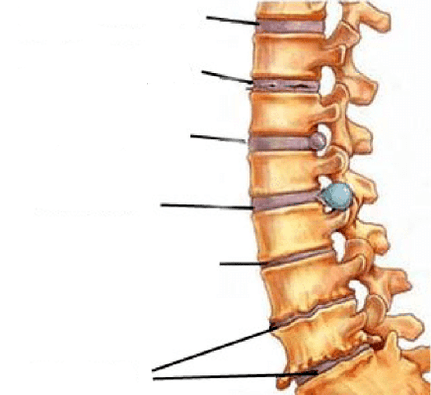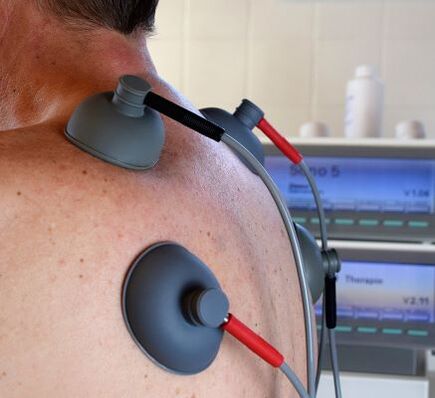Just imagine, in the 21st century, osteochondrosis is diagnosed in 50-80% of the world's population. The figures are not small, and most importantly, the disease is "getting younger". If earlier the first symptoms appeared no earlier than 35 years old, now the first signs are already diagnosed in adolescents. Most often, a predisposition to osteochondrosis is observed in people with an uneven load on the spine. This can be incorrect behavior, the habit of holding a bag on one shoulder, sitting for a long time in one position, injury, excessive sports load and, of course, age-related changes.
"Most people have finally heard about osteochondrosis, but not everyone knows what it is"
What is osteochondrosis?

Osteochondrosis is a pathology of the spine, expressed by degenerative damage to the intervertebral discs and adjacent bone tissue, which leads to the deletion of vertebral bodies and joint surfaces.
Unfortunately, when the first back pain appears, almost no one goes to the doctor, this leads to the fact that the disease is already detected in serious stages. The disease at an early stage is treated quite effectively, as the changes in the spine are not critical, but over time the process becomes irreversible.
The main sign that you may be developing osteochondrosis is pain in the neck, back or lower back. In a more advanced form, the pain "radiates" to the chest, arms, shoulders, legs and other parts of the body.
Depending on the location, osteochondrosis is divided into several types:
- Osteochondrosis of the cervix.
- Chest osteochondrosis.
- Osteochondrosis mesit.
Symptoms and signs of osteochondrosis
Clinical manifestations arise from damage to nerve tissue and blood vessels located near the affected area.
- Backache.
- Feeling "lumbago" after physical exertion.
- Poor posture and, as a result, scoliosis.
- Violation of skin sensitivity in certain areas of the body.
- Numbness.
- Dizziness and dizziness due to impaired blood supply.
- Headache.
Osteochondrosis can have a variety of symptoms and signs, so it is not always easy to detect it at the first signals. Go through periodic checkups and do not delay to go to the doctor at the first suspicion of osteochondrosis.
Causes of osteochondrosis

There can be many reasons for the development of osteochondrosis. As a rule, lack of proper respect for the spine leads to this disease, if not at a young age, then probably up to the age of 50 years.
Think about how you sit every day, how you sleep, if you have a comfortable pillow and if you always carry weights in one hand, if you give the right load when doing sports, as all this can lead to irreversible consequences in the back. . .
The reasons for the development of osteochondrosis can be:
- Genetic predisposition.
- Nervous exhaustion of the body.
- Poor posture during active growth.
- Wearing uncomfortable shoes.
- Wearing heels at an early age.
- Physical overload of the body.
- Mbipesha.
- Sedentary and sedentary lifestyle.
- Improper weight bearing.
- Frequent lifting of loads.
- Vibration loads on the body.
- Dehydration of the body.
- Hypothermia of the body.
"Note that being overweight and sitting will lead to back problems over time! "
In danger:
- Drivers.
- Office staff.
- Movers.
- Pregnant women.
- Thick
- Professional athletes.
Take care of your health and lead a healthy lifestyle.
Stages of development of osteochondrosis

None of the diseases start suddenly and immediately. Osteochondrosis is no exception. There are 4 main stages in the development of osteochondrosis.
- Primary dystrophic changes in the intervertebral cartilage. Disc dehydration, microcracks, loss of elasticity - all this is already happening in the spine, while you practically do not feel any change, but they are still there and you can notice them. If you start to notice back discomfort during prolonged sitting or slight pain after physical exertion, do not waste time, make an appointment with a doctor.
- Contraction of the intervertebral space and pinching of nerve endings and the appearance of pain in certain areas of the back. Pain syndrome will appear each time with sharp curves and tilt. This stage is hard to miss and certainly should not be ignored.
- Abrasion of intervertebral cartilage tissue. The symptoms of pain are pronounced and can lead to numbness of the limbs. It is impossible to relieve pain without medication. At this stage, serious treatment is required by adhering to the regimen and taking medication.
- The last and most serious stage. Osteochondrosis in it is already irreversible, as the intervertebral cartilage is completely destroyed. Surgery is usually required in such cases.
Advanced cases of osteochondrosis can lead to partial or complete paralysis. In order not to bring the situation to a critical state, it is required to begin timely treatment in the early stages of osteochondrosis development.
Treatment of osteochondrosis
For the treatment of osteochondrosis of the spine, an individual approach is required for each patient. There is no standard and uniform method of treatment. The age of the patient, his physical condition, the causes of osteochondrosis and many other factors are taken into account. But of course, each of the treatments has common features:
Medications for osteochondrosis

Osteochondrosis can not only be cured by taking medications, but they play a key role in reducing the severity of the disease symptoms, improving blood supply processes and tissue regeneration. For complete elimination of the disease, an integrated approach and maintenance of the body condition in proper condition throughout the rest of your life is required. Medications for osteochondrosis consist of taking several groups of medications.
- First of all, it is required to relieve the pain that interferes with a normal lifestyle. For these purposes, NSAIDs - non-steroidal anti-inflammatory drugs are used. (Ketoprofen, Ibuprofen, Ketorolac).
- After relieving the pain symptoms, chondroprotectors and vitamins are prescribed to restore cartilage tissue. Such drugs prevent further destruction of the intervertebral discs and reduce inflammation. Such drugs include Glucosamine, which, unlike analogues, does not need to be injected. Just dissolve a bag of powder in a glass of water and take it by mouth. This method of administration promotes better absorption of the drug and alleviates the discomfort that occurs during injections.
- Drugs that stimulate blood microcirculation.
- Local analgesics.
Physiotherapy for osteochondrosis

Treatment of osteochondrosis with physiotherapy is a very effective measure, and most importantly, it is painless and has virtually no contraindications. Such procedures help relieve inflammation, eliminate spasms, and eliminate tightening of nerve endings. Physiotherapy includes procedures such as:
- Electrophoresis.
- Magnetotherapy.
- Phototherapy.
- Shock wave therapy.
- Mud therapy.
It is worth noting that some physiotherapy procedures may not be used during periods of deterioration. Treatment of osteochondrosis with physiotherapy is prescribed exclusively by a doctor and in combination with medical treatment.
Physiotherapy and massage for osteochondrosis
Physiotherapy exercises for osteochondrosis helps in the formation of a muscular corset that will help support the diseased spine. The group of exercises is selected individually for each patient individually. For stage 3, the exercises are performed only during stretching, without problems and preferably under supervision.
Treating osteochondrosis with massage is also a common practice. The main thing is that the massage is done by a professional who will not hurt your spine. After the session, you should feel muscle relaxation, stacking and general relief. Manual massage improves blood circulation. In acute periods of the disease, it is better to reject this method of treatment.
Treatment of cervical osteochondrosis

With osteochondrosis of the cervical spine, the patient feels severe pain in the head, neck, arms, and shoulder girdle. There may be vibration of "flies", tinnitus and spots in front of the eyes. As a rule, in the early stages, the patient goes to examine the head and does not suspect that the issue is completely different. With osteochondrosis of the cervix are prescribed.
- Agnioprotectants against vertigo, which most often appears in the morning (Pentoxifylline).
- Chondroprotectors that prevent further destruction of cartilage tissue, reduce inflammation, relieve pain and restore joint movement (Glucosamine, Chondroitin sulfate).
- Antidepressants, which sometimes need to be administered by patients due to the fact that constant pain has a detrimental effect on the psyche and contributes to the development of insomnia, depression (Doxylamin).
- Vitamins that will improve the overall condition of the body.
- Anti-colvusants for headaches that interfere with the full life of patients.
- NSAIDs are prescribed in the acute period to relieve pain.
Treatment of chest osteochondrosis
With osteochondrosis of the thoracic spine, there is sharp pain in the front of the chest, and breathing can become frequent and heavy. There may be sharp pain when you turn and bend in the area of the shoulder blades. It is difficult to diagnose thoracic osteochondrosis, as the pain is not felt directly in the back, and the symptoms are more similar to heart, lung, or kidney disease. Fortunately, this type of osteochondrosis is very rare and the cause of its occurrence is in most cases scoliosis.
Treatment of lumbar osteochondrosis
Lumbar osteochondrosis is the most common type at the present time. This is due to the fact that this particular part of the spine is subject to the greatest stress. First, a dull ache appears in the lumbar region, then the pain begins to radiate to the legs and can lead to numbness of the lower extremities. Bending and elongation problems arise. In such cases, the main thing is to start timely treatment of lumbar osteochondrosis and apply complex measures. Some rules must be followed:
- Limit physical activity.
- Take all prescribed medications.
- Do prescribed physiotherapy.
- Take a special massage course.
- Get rid of excess weight if necessary.
With improper treatment and non-compliance with the recommendations, surgery may be required in late lumbar osteochondrosis.
Which doctor treats osteochondrosis?
If you feel pain in the spine and suspect you have osteochondrosis, then you should first schedule an appointment with a therapist, who, based on your complaints, will refer you to a neurologist, vertebrologist, orthopedist and surgeon for examination.
How long is osteochondrosis treated?
Many patients are interested in how long will the treatment of osteochondrosis last? No one will give you a correct answer, but the main signs of the disease disappear, as a rule, within 1-3 months, further maintenance of the condition is required.
Is It Possible To Get Rid Of Osteochondrosis Forever?
It all depends on the stage at which it was discovered. If the patient returns in 1-2 stages, then with proper treatment and observance of all the rules, you can get rid of osteochondrosis forever. In the later stages, unfortunately, it will not be possible to get rid of the disease completely.
Orthopedic pillow
You may need an orthopedic pillow if you have been diagnosed with cervical osteochondrosis. This pillow will improve the quality of your sleep and will not continue to deform your spine. You can contact a special shop, where advisors will show you all the options for pillows and advise you on prices.































